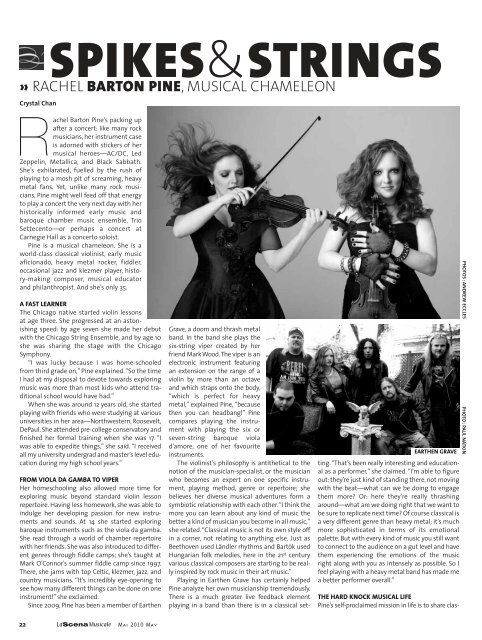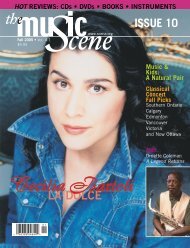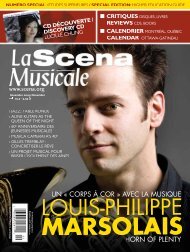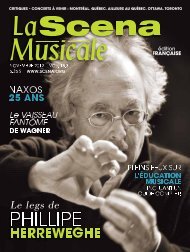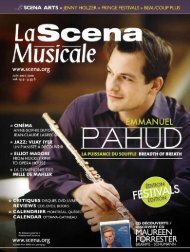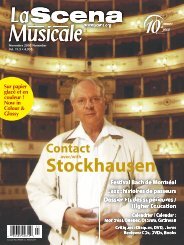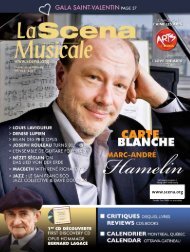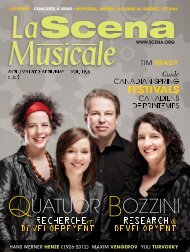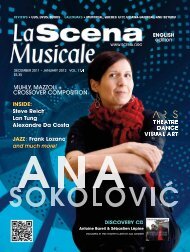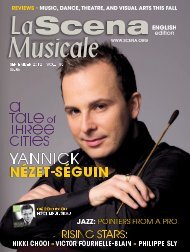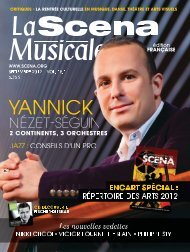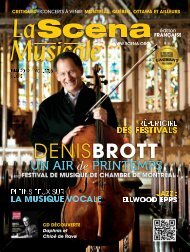Adobe Acrobat PDF complet (6 Meg) - La Scena Musicale
Adobe Acrobat PDF complet (6 Meg) - La Scena Musicale
Adobe Acrobat PDF complet (6 Meg) - La Scena Musicale
You also want an ePaper? Increase the reach of your titles
YUMPU automatically turns print PDFs into web optimized ePapers that Google loves.
SPIKES&STRINGS<br />
» RACHEL BARTON PINE, MUSICAL CHAMELEON<br />
Crystal Chan<br />
Rachel Barton Pine’s packing up<br />
after a concert: like many rock<br />
musicians, her instrument case<br />
is adorned with stickers of her<br />
musical heroes—AC/DC, Led<br />
Zeppelin, Metallica, and Black Sabbath.<br />
She’s exhilarated, fuelled by the rush of<br />
playing to a mosh pit of screaming, heavy<br />
metal fans. Yet, unlike many rock musicians,<br />
Pine might well feed off that energy<br />
to play a concert the very next day with her<br />
historically informed early music and<br />
baroque chamber music ensemble, Trio<br />
Settecento—or perhaps a concert at<br />
Carnegie Hall as a concerto soloist.<br />
Pine is a musical chameleon. She is a<br />
world-class classical violinist, early music<br />
aficionado, heavy metal rocker, fiddler,<br />
occasional jazz and klezmer player, history-making<br />
composer, musical educator<br />
and philanthropist. And she’s only 35.<br />
A FAST LEARNER<br />
The Chicago native started violin lessons<br />
at age three. She progressed at an astonishing<br />
speed: by age seven she made her debut<br />
with the Chicago String Ensemble, and by age 10<br />
she was sharing the stage with the Chicago<br />
Symphony.<br />
“I was lucky because I was home-schooled<br />
from third grade on,” Pine explained.“So the time<br />
I had at my disposal to devote towards exploring<br />
music was more than most kids who attend traditional<br />
school would have had.”<br />
When she was around 12 years old, she started<br />
playing with friends who were studying at various<br />
universities in her area—Northwestern, Roosevelt,<br />
DePaul. She attended pre-college conservatory and<br />
finished her formal training when she was 17. “I<br />
was able to expedite things,” she said. “I received<br />
all my university undergrad and master’s level education<br />
during my high school years.”<br />
FROM VIOLA DA GAMBA TO VIPER<br />
Her homeschooling also allowed more time for<br />
exploring music beyond standard violin lesson<br />
repertoire. Having less homework, she was able to<br />
indulge her developing passion for new instruments<br />
and sounds. At 14 she started exploring<br />
baroque instruments such as the viola da gamba.<br />
She read through a world of chamber repertoire<br />
with her friends. She was also introduced to different<br />
genres through fiddle camps; she’s taught at<br />
Mark O’Connor’s summer fiddle camp since 1997.<br />
There, she jams with top Celtic, klezmer, jazz, and<br />
country musicians. “It’s incredibly eye-opening to<br />
see how many different things can be done on one<br />
instrument!” she exclaimed.<br />
Since 2009, Pine has been a member of Earthen<br />
EARTHEN GRAVE<br />
Grave, a doom and thrash metal<br />
band. In the band she plays the<br />
six-string viper created by her<br />
friend Mark Wood.The viper is an<br />
electronic instrument featuring<br />
an extension on the range of a<br />
violin by more than an octave<br />
and which straps onto the body,<br />
“which is perfect for heavy<br />
metal,” explained Pine, “because<br />
then you can headbang!” Pine<br />
compares playing the instrument<br />
with playing the six or<br />
seven-string baroque viola<br />
d’amore, one of her favourite<br />
instruments.<br />
The violinist’s philosophy is antithetical to the<br />
notion of the musician-specialist, or the musician<br />
who becomes an expert on one specific instrument,<br />
playing method, genre or repertoire; she<br />
believes her diverse musical adventures form a<br />
symbiotic relationship with each other.“I think the<br />
more you can learn about any kind of music the<br />
better a kind of musician you become in all music,”<br />
she related.“Classical music is not its own style off<br />
in a corner, not relating to anything else. Just as<br />
Beethoven used Ländler rhythms and Bartòk used<br />
Hungarian folk melodies, here in the 21 st century<br />
various classical composers are starting to be really<br />
inspired by rock music in their art music.”<br />
Playing in Earthen Grave has certainly helped<br />
Pine analyze her own musicianship tremendously.<br />
There is a much greater live feedback element<br />
playing in a band than there is in a classical setting.“That’s<br />
been really interesting and educational<br />
as a performer,” she claimed. “I’m able to figure<br />
out: they’re just kind of standing there, not moving<br />
with the beat—what can we be doing to engage<br />
them more? Or: here they’re really thrashing<br />
around—what are we doing right that we want to<br />
be sure to replicate next time? Of course classical is<br />
a very different genre than heavy metal; it’s much<br />
more sophisticated in terms of its emotional<br />
palette. But with every kind of music you still want<br />
to connect to the audience on a gut level and have<br />
them experiencing the emotions of the music<br />
right along with you as intensely as possible. So I<br />
feel playing with a heavy metal band has made me<br />
a better performer overall.”<br />
THE HARD KNOCK MUSICAL LIFE<br />
Pine’s self-proclaimed mission in life is to share clas-<br />
PHOTOS : ANDREW ECCLES<br />
PHOTO : PAUL NATKIN<br />
22 Mai 2010 May


